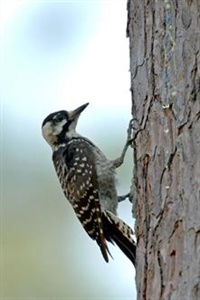Thanks to efforts by the Arkansas Natural Heritage Commission (ANHC), and its partners throughout the state, red-cockaded woodpecker (Picoides borealis, RCW) populations increased this year on three ANHC natural areas.
The RCW was listed as federally endangered by the U.S. Fish and Wildlife Service (USFWS) in 1970 and received the protection of the Endangered Species Act (ESA) with its passage in 1973. Many factors contributed to RCWs becoming endangered, including loss of habitat throughout their range, fragmentation of remaining habitat, and the removal of fire from the ecosystem.
RCWs require open, mature pine forests for habitat, which were once common throughout southern Arkansas. Fire is critical in the development and maintenance of this habitat. ANHC and partners, ranging from non-profit conservation groups to industrial timber companies, have collaborated over the last several years to address these issues. Historical fire frequency has been reestablished and the amount of connectivity of available habitat has increased through grants and other funding sources.
The response of the RCWs in the natural state to these collective efforts has been encouraging and gratifying. The RCW population at Pine City Natural Area was once nearly lost, decreasing to only one group of RCWs, consisting of a total of three birds (this species often has previous offspring that help with nest activity like incubating eggs). This year the site grew to four active groups with 12 adults that fledged 8 young.
At Moro Big Pine Natural Area-Wildlife Management Area, the RCW numbers grew to 21 active groups this year compared to only 14 groups four years ago. This is attributed to several years of excellent habitat management by Potlatch Timber Company, the fee owner of the property (ANHC and the Arkansas Game and Fish Commission own a Conservation Easement) who conducted a yearly average of prescribed burns on about 4,000 acres per year.
The RCW repatriation effort at Warren Prairie Natural Area continues to excel, increasing from 9 active groups last year to 13 this year, with a total of approximately 30 birds. This site had fallen to zero birds for over two decades until 2010 when birds were released there. The large growth at Warren Prairie NA followed the best year of prescribed burning at this site.
The RCW is a keystone species for the open, mature pine habitat and where RCWs makes a comeback, northern bobwhite (Colinus virginianus), wild turkey (Meleagris gallopavo), and even Arkansas’s state butterfly, Diana fritillary (Speyeria diana) flourish. The ANHC and its partners actively manage open pine habitat through regular prescribed fire implementation and other means to ensure that populations of RCWs and their associates continue to grow.
